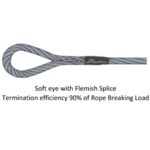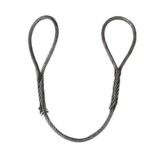The spliced wire rope sling has the characteristics of high strength, light deadweight, stable operation, and not easy to suddenly break the whole piece, and is widely used in steel, chemical, transportation, port and other industries
Contrast between inserting and pressing:
- Under the same diameter, the aluminum sleeve is pressed and the casting capacity is large and safer.
- If it is steel core wire rope, it is difficult to insert and weave.
- Aluminum alloy pipe is pressed and cast with less rope.
- Large amount of wire rope is used for splicing and wire rope clamp.
- When connecting with rope clips, pay attention to the matching ratio between the wire rope diameter, the number of rope clips and the distance between rope clips.
- The compression consolidation rate is about 0.9, and the interpolation is about 0.65.
Precautions:
- Users shall be familiar with the performance, precautions and scrapping standards of various wire rope slings and their end fittings.
- The steel wire rope sling selected shall adapt to the shape characteristics and specific requirements of the workpiece to be hoisted, and shall never be used without the conditions for use.
- Before operation, the wire rope and its accessories shall be inspected and confirmed to be in good condition before use.
- The cable points shall be correctly selected before hanging; Before lifting, confirm whether the binding is firm.
- Slings and accessories shall not exceed their rated lifting capacity, and slings shall not exceed their maximum working load under corresponding hanging conditions
- During operation, it is required to prevent damage to wire rope slings and accessories, and if necessary, corner protection shall be provided at corners.
- Regular inspection shall be carried out for wire rope slings during their service life. If conditions permit, flaw detection shall be carried out for slings and end fittings of large tonnage and important products.


